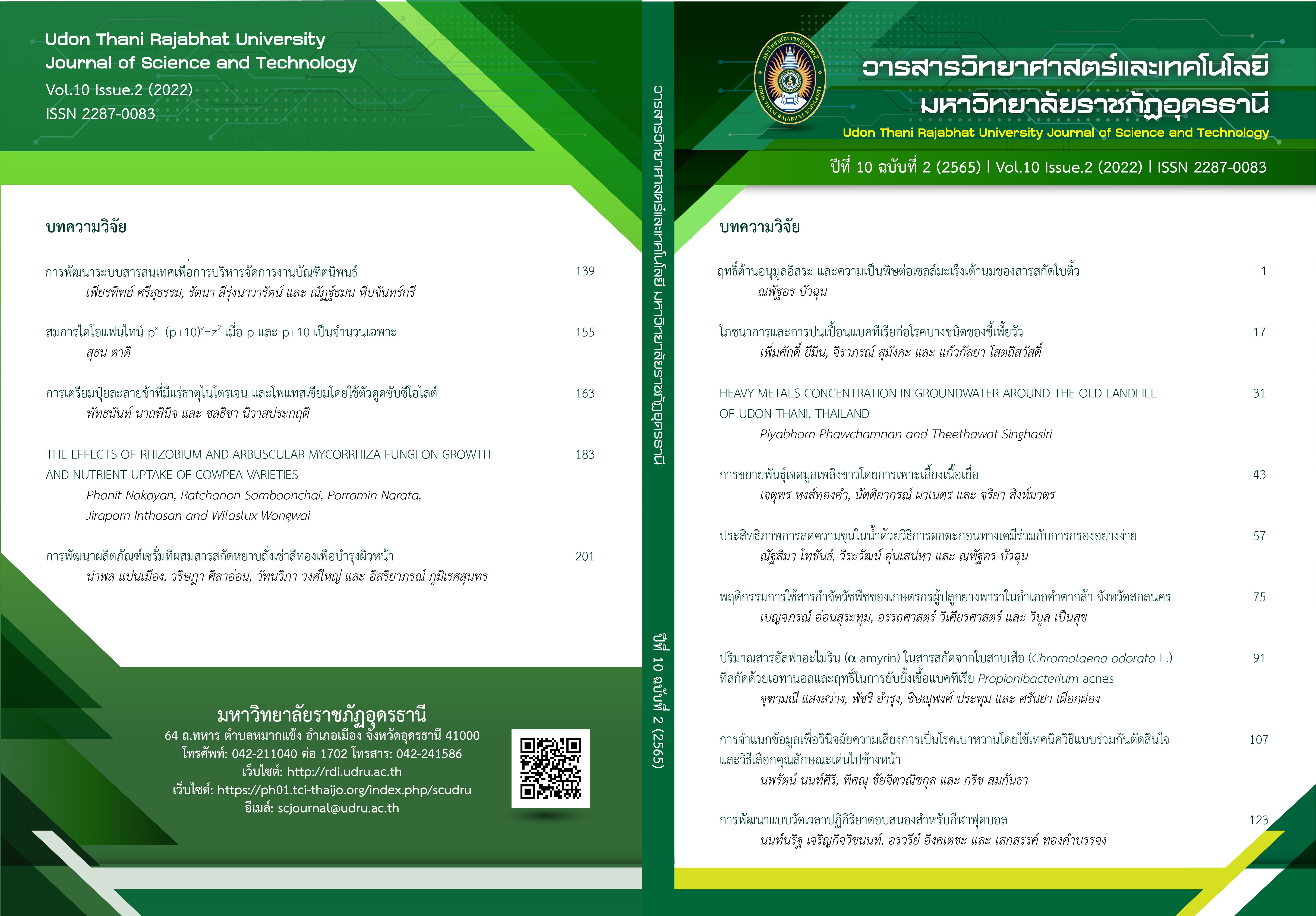THE EFFECTS OF RHIZOBIUM AND ARBUSCULAR MYCORRHIZA FUNGI ON GROWTH AND NUTRIENT UPTAKE OF COWPEA VARIETIES
Main Article Content
บทคัดย่อ
The study was conducted to determine the effects of rhizobium and Arbuscular mycorrhiza fungi (AMF) on the growth of three cowpea varieties (Vigna unguiculata L. Walp.). The cowpea inoculated with three Rhizobium strains (R14, R41 and R55) and four AMF strains (AMF1, AMF2, AMF3 and AMF4) were evaluated with a pot experiment under greenhouse conditions. The experiment consisted of 3 groups and each group was divided into six treatments in completely randomized design: (1) control treatment (non-inoculated plant), (2) rhizobium treatment (inoculated with rhizobium isolated R14, R41 and R55 for cowpea no. 14, 41, and 55, respectively), (3) AMF1 treatment (dual inoculation with each rhizobium and AMF1), (4) AMF2 treatment (dual inoculation with each rhizobium and AMF2), (5) AMF3 treatment (dual inoculation with each rhizobium and AMF3) and (6) AMF4 treatment (dual inoculation with each rhizobium and AMF4). The results showed that rhizobium inoculation increased shoot dry weight of all cowpea varieties higher than control treatment with 14, 45, and 28%, respectively. The cowpea no.14 and 41 that rhizobium inoculation increased the amounts of nitrogen from nitrogen-fixation higher than control treatment by 70 and 47%, respectiv ely. The dual inoculation of rhizobium and AMF on a percentage of mycorrhizal colonization and phosphorus content were not statistically significant from the control treatment. The amounts of nitrogen from nitrogen-fixation of cowpea strain 14 and 55 with dual inoculation of Rhizobium R14 or R15 and all groups of AMF were lower than a single rhizobium inoculation. The amounts of nitrogen from nitrogen-fixation of cowpea strain 41 and 55 with dual inoculation of rhizobium R14 and AMF2 or AMF3 or AMF4 were higher than a single rhizobium inoculation. This study concluded that the growth of cowpea and amounts of nitrogen from nitrogen-fixation of cowpea could have been improved by specific rhizobium. However, the dual inoculation of rhizobium and arbuscular mycorrhizal remains to be considered on a case-by-case basis.
Article Details
เอกสารอ้างอิง
Bado, B. V., Bationo, A., & Cescas, M. P. (2006). Assessment of cowpea and groundnut contributions to soil fertility and succeeding sorghum yields in the Guinean savannah zone of Burkina Faso (Weat Africa). Biology and Fertility of Soils, 43, 171-176.
Boddey, L. M., Fosu, M., Atakora, W. K., Miranda, C. H. B., Boddey, L. H., Guimaraes, A. P., & Ahiabor, B. D. K. (2016). Cowpea (Vigna unguiculata) crops in Africa can respond to inoculation with rhizobium. Experimental Agriculture, 53(4), 578-587.
Dabo, M., Jaiswal, S. K., & Dakora, F. D. (2019). Phylogenetic evidence of allopatric speciation of bradyrhizobia nodulating cowpea (Vigna unguiculata L. walp) in South African and Mozambican soils. FEMS Microbiology Ecology, 9(6), 1-14.
Estefan, G., Sommer, R., & Ryan, J. (2013). Methods of soil, plant, and water analysis: A manual for the West Asia and North Africa region. 3nd Eidition. International Center for Agricultural Research in the Dry Areas. Beirut.
Herridge, D. E., & Peoples, M. B. (2002). Timing of xylem sampling for ureide analysis of nitrogen fixation. Plant and Soil, 38, 57-67.
Klabi, R., Hamel, C., Schellenberg, M. P., Iwaasa, A., Raies, A., & St-Arnaud, M. (2014). Interaction between legume and arbuscular mycorrhiza fungi identity alters the competitive ability of warm-season grass species in a grassland community. Soil Biology and Biochemistry, 70, 176-182.
Lebrazi, S., Fadil, M., Chraibi, M., & Fikri-Benbrahim, K. (2020). Screening and optimization of indole-3-acetic acid production by Rhizobium sp. strain using response surface methodology. Journal of Genetic Engineering and Biotechnology, 18(20), 1-10.
Meng, L., Zhang, A., Wang, F., Han, X., Wang, D., & Li, S. (2015). Arbuscular mycorrhizal fungi and rhizobium facilitate nitrogen uptake and transfer in soybean/maize intercropping system. Frontiers in Plant Science, 6, 1-10.
Murdock, L. L., Sithole-Niang, I., & Higgins,T. J. V. (2010). Transforming the cowpea, an African orphan staple crop grown predominantly by women. pp. 211-232. In: J. David and et al.(ed.). Successful Agricultural Innovation in emerging economics: New genetic technologies for global food production. Cambridge University Press. Cambridge.
Phillips, J. M., & Hayman, D. S. (1970). Improved producer for clearing root and staining parasitic and vesicular-arbuscular mycorrhiza fungi for rapid assessment of infection. Transactions of the British Mycological Society, 55, 158-161.
Püschel, D., Janoušková, M., Voříšková, A., Gryndlerová, H., Vosátka, M., & Jansa, J. (2017). Arbuscular mycorrhiza stimulates biological nitrogen fixation in two Medicago spp. through improved phosphorus acquisition. Frontiers in Plant Science, 8, 1-12.
Rebika, T., & Nongmaithem, N. (2019). Effect of Rhizobium inoculation on yield and nodule formation of coepea. International journal of current microbiology and applied sciences, 8(11), 134-139.
Tang, T. T., Xie, M. M., Chen, S. M., Zhang, S. M., & Wu, Q. S. (2019). Effect of arbuscular mycorrhizal fungi and rhizobia on physiological activities in White Clover (Trifolium repens). Biotechnology, 18(2), 49-54.
Wongwai, W., Choengaksorn, C., Hassarangsee, S. Leelapiromkul, P., Chaimongkol, N., & Khunpiluk, P. (2014). Developmemt on crawling cowpea production in upland and highland cropping system. Khon Kaen Agriculture Journal, 47(Suppl.2), 298-303. (in Thai)
Wongwai, W., Leelapiromkul, P., Choengaksorn, C., Hassarangsee, S., Yotharath, S., Punchaisri, K., Meekul, P., Chitta, P., & Nakayan, P. (2017). Varieties selection of crawling cowpea for growing with upland rice in highland cropping system. In: Proceedings of 6th National Conference on Legumes. 23-25 August 2017, Nakhon Si Thammarat, Thailand. 181-190. (in Thai)
Young, C. C. (2014). Soil and fertilizer concepts and practices. Airti Press Inc. New Taipei City, Taiwan.


